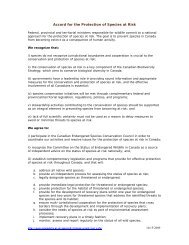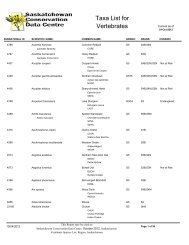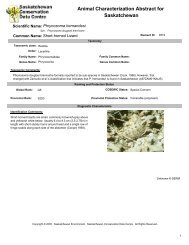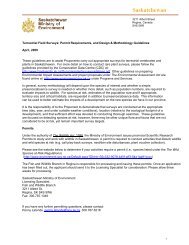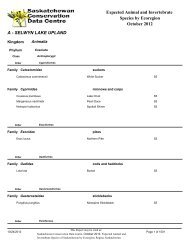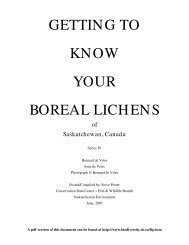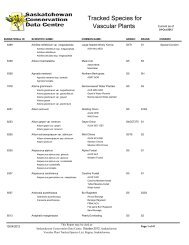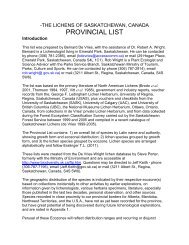Kakithaw-piyak - Saskatchewan Conservation Data Centre
Kakithaw-piyak - Saskatchewan Conservation Data Centre
Kakithaw-piyak - Saskatchewan Conservation Data Centre
Create successful ePaper yourself
Turn your PDF publications into a flip-book with our unique Google optimized e-Paper software.
“<strong>Kakithaw</strong>-<strong>piyak</strong>”<br />
Everything is One<br />
Compiled by:<br />
Adam L. Kosowan<br />
Jim R. Smith<br />
January 2004
NOTES<br />
14<br />
DEDICATION<br />
This publication is dedicated to the memory of Wayne Harris, who tragically<br />
passed away on October 7, 2002.<br />
As an employee of the Department of Environment for 13 years, Wayne was a<br />
special person with breadth and depth in a variety of resource disciplines. He<br />
had a passion for raptors, and banding young Ferruginous and Swainson’s<br />
hawks became part of his job. He went the extra mile to obtain information on<br />
endangered species, putting in long and grueling field days followed by early<br />
morning and late night hours in the office, documenting information and<br />
networking with others to advance the protection of <strong>Saskatchewan</strong>’s<br />
biodiversity. Wayne co-operated with the oil and gas industry to determine<br />
methods, which allowed for development, while minimizing impacts on the<br />
wildlife resource, particularly native vegetation. He recognized the importance<br />
of reducing the impacts of exotic species, to the extent that he made a personal<br />
effort to remove Japanese brome from pastures in the southwest corner of the<br />
province.<br />
As a respected and prominent ecologist, Wayne authored and co-authored<br />
numerous publications within and outside government. Some of his written<br />
work includes a pioneer effort in preparing a description of understory<br />
vegetation within various forest ecosystems.<br />
His dedicated and professional ethic is acknowledged. His caring for the<br />
environment and contributions of time and knowledge remain a legacy.
TABLE OF CONTENTS<br />
Acknowledgements .................................................................................................1<br />
Introduction .............................................................................................................2<br />
Site Definitions........................................................................................................4<br />
Species by Site Type – Grasses, Sedges and Rushes...............................................5<br />
Species by Site Type – Forbs ..................................................................................8<br />
Species by Site Type – Shrubs ................................................................................11<br />
Information Sources ................................................................................................13<br />
FIGURES<br />
Mid-Boreal Upland, Mid-Boreal Lowland and Boreal Transition Ecoregions<br />
in <strong>Saskatchewan</strong> ......................................................................................................3<br />
INFORMATION SOURCES<br />
Acton, D. F., G.A. Padbury and C.T. Stushnoff (Principal Authors) and L.<br />
Gallagher, D. Gauthier, L. Kelly, T. Radenbaugh and J. Thorpe<br />
(Contributing Authors). 1998. The Ecoregions of <strong>Saskatchewan</strong>.<br />
<strong>Saskatchewan</strong> Environment and Resource Management and Canadian<br />
Plains Research Center, University of Regina. 205 pp.<br />
Gerling, S. G., M. G. Willoughby, A. Schoepf, K. E. Tannas and C. A. Tannas.<br />
1996. A Guide to Using Native Plants on Disturbed Lands. Alberta<br />
Agriculture, Food and Rural Development and Alberta Environmental<br />
Protection. ISBN 0-7732-6125-7. 247 pp.<br />
Hardy BBT Limited. 1989. Manual of Plant Species Suitability for<br />
Reclamation in Alberta – 2 nd Edition. Alberta Land <strong>Conservation</strong> and<br />
Reclamation Council Report No. RRTAC 89-4. 436 pp.<br />
Harris, W.C. Revised 1989. A Guide to Forest Understory Vegetation in<br />
<strong>Saskatchewan</strong>. Government of <strong>Saskatchewan</strong> and Forestry Canada.<br />
106 pp.<br />
Johnson, D., L. Kershaw, A. MacKinnon and J. Pojar. 1995. Plants of the<br />
Western Boreal Forest and Aspen Parkland. Lone Pine Publishing<br />
and the Canadian Forestry Service. ISBN 1-55105-058-7. 392 pp.<br />
Kabzems, A., A.L. Kosowan and W.C. Harris. 1986. Mixedwood Section in<br />
an Ecological Perspective <strong>Saskatchewan</strong>. Technical Bulletin No. 8,<br />
Second Edition. <strong>Saskatchewan</strong> Parks and Renewable Resources and<br />
Canadian Forestry Service. 122 pp.<br />
Native Plant Society of <strong>Saskatchewan</strong>. info@npss.sk.ca<br />
<strong>Saskatchewan</strong> <strong>Conservation</strong> <strong>Data</strong> <strong>Centre</strong>. http://www.biodiversity.sk.ca<br />
Wark D.B., W.R. Poole, R.G. Arnott, L.R. Moats and I. Wetter. Revegetating<br />
with Native Grasses. Ducks Unlimited Canada. 133 pp.<br />
13
SPECIES BY SITE TYPE – SHRUBS<br />
Labrador tea<br />
(Ledum groenlandicum)<br />
leatherleaf<br />
(Chamaedaphne calyculata)<br />
low bush-cranberry<br />
(Viburnum edule)<br />
northern bog-laurel<br />
(Kalmia polifolia)<br />
pin cherry<br />
(Prunus pensylvanica)<br />
prickly rose<br />
(Rosa acicularis)<br />
red-osier dogwood<br />
(Cornus stolonifera; Cornus sericea ssp. stolonifer)<br />
river alder<br />
(Alnus tenuifolia; Alnus incana ssp. tenuifolia)<br />
Saskatoon<br />
(Amelanchier alnifolia)<br />
shrubby cinquefoil<br />
(Potentilla fruticosa; Dasiphora fruticosa ssp. floribunda)<br />
small bog cranberry<br />
(Oxycoccus micrcarpus; Vaccinium oxycoccos)<br />
twining honeysuckle<br />
(Lonicera dioica)<br />
wild gooseberry<br />
(Ribes oxyacanthoides)<br />
wild red raspberry<br />
(Rubus idaeus ssp. strigosus)<br />
willows<br />
(Salix spp.)<br />
D<br />
R<br />
Y<br />
F<br />
R<br />
E<br />
S<br />
H<br />
SITE<br />
M<br />
O<br />
I<br />
S<br />
T<br />
W<br />
E<br />
T<br />
O<br />
R<br />
G<br />
A<br />
N<br />
I<br />
C<br />
ACKNOWLEDGEMENTS<br />
This report is a collaborative effort between government and non-government<br />
participants. It has been prepared as a practical guide to assist in the use of<br />
native species for rehabilitating disturbed areas. <strong>Saskatchewan</strong> Environment<br />
staff leading preparation of the report includes: Adam Kosowan, Jim R.<br />
Smith, Rob Wright, Ann Gerry, Sheila Lamont and Bob Wilson.<br />
Thanks are extended to Dr. Jim Romo, Professor, University of <strong>Saskatchewan</strong><br />
and the students from the Landscape Ecology and Vegetation Management<br />
Class (John Conkin, Sherry Stewart, Jennifer Fernet, Andrew Pantel, Neil<br />
Block, Tara Sample, Debbie Borowsky and Tim L’ Arrivee). The student<br />
papers provided a basis for this report.<br />
The project was further advanced by Joel Ulmer, a summer student with<br />
<strong>Saskatchewan</strong> Environment, who synthesized the student reports. The work<br />
undertaken by Joel is appreciated.<br />
The assistance provided by Dr. Vernon Harms, Professor emeritus, University<br />
of <strong>Saskatchewan</strong> and John H. Hudson, Botanist, with reviewing the report is<br />
gratefully acknowledged.<br />
Thanks are also extended to Ron Erickson, Director, and Chris Dunn,<br />
Integrated Resource Manager, Prince Albert, for their administrative support,<br />
and to numerous other <strong>Saskatchewan</strong> Environment colleagues for their<br />
contributions.<br />
12 1
INTRODUCTION<br />
The maintenance of ecological structure, function and composition requires an<br />
understanding of natural ecosystems, and the corresponding application of that<br />
knowledge. Humans are unable to replicate pre-disturbance natural processes,<br />
but are able to minimize the impacts of man-made disturbances on the<br />
landscape and facilitate recovery toward a natural system.<br />
Exotic species are recognized as a threat to the maintenance of natural<br />
biodiversity. Studies by <strong>Saskatchewan</strong> Environment have demonstrated that<br />
soil exposure provides a favorable location for the establishment of<br />
undesirable plant species. Early re-establishment of native species on disturbed<br />
sites is recommended for mitigation. The intent of this report is to serve as a<br />
practical guide for the selection of suitable native species to reclaim<br />
disturbances within the Mid-Boreal Upland, Mid-Boreal Lowland and Boreal<br />
Transition Ecoregions (Figure 1).<br />
As disturbances generally result in habitats exposed to sunlight, the species<br />
listed are suitable for sunlight conditions. They are organized within the<br />
following site categories: dry, fresh, moist, wet and organic. Proportionally, it<br />
is suggested that the dry, fresh and moist site species mixes contain 80 to 90%<br />
grasses (and grass-like) and 10 to 20% forbs. The wet and organic site species<br />
should contain approximately 95% grasses (and grass-like) and the balance<br />
forbs. Four or more grass (and grass-like) species and four or more forb<br />
species should be used in the mix. To confirm proper species selection and<br />
locate rare species, proponents are encouraged to undertake vegetation surveys<br />
prior to development.<br />
The species listings are based on ecological suitability without consideration to<br />
seed procurement (purchase or collection). It is suggested that users obtain<br />
additional information on species characteristics prior to purchasing seed and<br />
planting. Local origin seed with purity from weeds is recommended.<br />
Additional information sources are identified in this report.<br />
The authors believe that this report is a useful starting point and encourage<br />
future efforts toward a better understanding of site and species relationships.<br />
alder-leaved buckthorn<br />
(Rhamnus alnifolia)<br />
beaked hazelnut<br />
(Corylus cornuta)<br />
bearberry<br />
(Arctostaphylos uva-ursi)<br />
bog birch<br />
(Betula glandulosa; Betula nana)<br />
Canada blueberry<br />
(Vaccinium myrtilloides)<br />
bracted honeysuckle<br />
(Lonicera involucrata)<br />
Canada buffaloberry<br />
(Shepherdia canadensis)<br />
chokecherry<br />
(Prunus virginiana var. melanocarpa)<br />
common juniper<br />
(Juniperus communis)<br />
common snowberry<br />
(Symphoricarpos albus)<br />
creeping juniper<br />
(Juniperus horizontalis)<br />
dry-ground cranberry<br />
(Vaccinium vitis-idaea)<br />
dwarf birch<br />
(Betula pumila var. glandulifera)<br />
dwarf bog-rosemary<br />
(Andromeda polifolia)<br />
fly honeysuckle<br />
(Lonicera villosa)<br />
green alder<br />
(Alnus crispa; Alnus viridis ssp. crispa)<br />
high bush-cranberry<br />
(Viburnum trilobum; Viburnum opulus)<br />
SPECIES BY SITE TYPE – SHRUBS<br />
2 11<br />
D<br />
R<br />
Y<br />
F<br />
R<br />
E<br />
S<br />
H<br />
SITE<br />
M<br />
O<br />
I<br />
S<br />
T<br />
W<br />
E<br />
T<br />
O<br />
R<br />
G<br />
A<br />
N<br />
I<br />
C
SPECIES BY SITE TYPE – FORBS<br />
Richardson’ s alumroot<br />
(Heuchera richardsonii)<br />
seaside arrow-grass<br />
(Triglochin maritima)<br />
shore buttercup<br />
(Ranunculus cymbalaria)<br />
showy aster<br />
(Aster conspicuus; Eurybia conspicua)<br />
silverweed<br />
(Potentilla anserina; Argentina anserina)<br />
small bedstraw<br />
(Galium trifidum)<br />
small-leaved pussytoes<br />
(Antennaria microphylla)<br />
smooth fleabane<br />
(Erigeron glabellus)<br />
spreading dogbane<br />
(Apocynum androsaemifolium)<br />
star-flowered false solomon’ s-seal<br />
(Smilacina stellata; Maianthemum stellatum)<br />
sweet-scented bedstraw<br />
(Galium triflorum)<br />
tall bluebells<br />
(Mertensia paniculata)<br />
three-leaved false solomon’ s-seal<br />
(Smilacina trifolia; Maianthemum trifolium)<br />
veiny meadow rue<br />
(Thalictrum venulosum)<br />
water parsnip<br />
(Sium suave)<br />
Western Canada violet<br />
(Viola Canadensis var. rugulosa)<br />
western dock<br />
(Rumex occidentalis; Rumex aquaticus var. fenestratus)<br />
western willow aster<br />
(Aster hesperius; Symphyotrichum lanceolatum ssp. hesperium)<br />
wild lily-of-the-valley<br />
(Maianthemum canadense)<br />
wild mint<br />
(Mentha arvensis)<br />
wild strawberry<br />
(Fragaria virginiana)<br />
woodland strawberry<br />
(Fragaria vesca)<br />
yellow marsh-marigold<br />
(Caltha palustris)<br />
10<br />
D<br />
R<br />
Y<br />
F<br />
R<br />
E<br />
S<br />
H<br />
SITE<br />
M<br />
O<br />
I<br />
S<br />
T<br />
W<br />
E<br />
T<br />
O<br />
R<br />
G<br />
A<br />
N<br />
I<br />
C<br />
Figure 1. Mid-Boreal Upland, Mid-Boreal Lowland and Boreal Transition<br />
Ecoregions in <strong>Saskatchewan</strong>.<br />
3
SITE DEFINITIONS<br />
Dry: Moisture and nutrient deficient sites, commonly supporting jack pine<br />
forests (rapidly drained sands). Examples include the Nisbet and Fort-àla-Corne<br />
Provincial Forests. These are the driest sites supporting forest<br />
growth.<br />
Fresh: These sites are commonly differentiated from the dry category by the<br />
presence of clay or silt in the soil profile. They are topographically<br />
located from the mid to upper slope positions. Coarse soils (sands) may<br />
also occur in this site category; however, they are topographically<br />
located on lower slopes where groundwater or runoff influences<br />
vegetation growth. A variety of boreal tree species may be found on<br />
these sites of average growing conditions.<br />
Moist: Soils within this site category may be a variety of textures (sands,<br />
clays etc). Due to topography (mid-slope to depression), landscape<br />
(productive lowland) or other influence, more water is available for plant<br />
growth than in the previous categories. These are the most productive<br />
forest sites on which a variety of boreal forest species may be found.<br />
Wet: These sites are seasonally saturated or located in areas with a higher<br />
water table. The soils may be a variety of textures (sands, clays etc.) and<br />
are usually overlain by a shallow layer of peat. These poorly drained<br />
sites are usually occupied by black spruce, white spruce and tamarack or<br />
may consist of meadows located in depressions.<br />
Organic: Prolonged saturation and organic matter accumulation (> 40 cm) are<br />
characteristic of these sites. They are located in areas with a high water<br />
table and commonly termed bogs and fens. The bogs may contain a<br />
black spruce and/or tamarack forest cover; whereas, the dominant<br />
vegetation of fens are grasses and grass-like species.<br />
SPECIES BY SITE TYPE – FORBS<br />
giant hyssop<br />
(Agastache foeniculum)<br />
golden dock<br />
(Rumex maritimus)<br />
lapland buttercup<br />
(Ranunculus lapponicus)<br />
Lindley’ s aster<br />
(Aster ciliolatus; Symphyotrichum ciliolatum)<br />
long-leaved starwort<br />
(Stellaria longifolia)<br />
long-stalked chickweed<br />
(Stellaria longipes)<br />
Macoun’ s buttercup<br />
(Ranunculus macounii)<br />
marsh aster<br />
(Aster borealis; Symphyotrichum boreale)<br />
marsh hedge-nettle<br />
(Stachys palustris var. pilosa; Stachys pilosa)<br />
marsh ragwort<br />
(Senecio congestus)<br />
marsh skullcap<br />
(Scutellaria galericulata)<br />
mountain goldenrod<br />
(Solidago spathulata; Solidago simplex ssp. simplex)<br />
narrow-leaved dock<br />
(Rumex salicifolius var. mexicanus)<br />
narrow-leaved hawkweed<br />
(Hieracium umbellatum)<br />
northern bedstraw<br />
(Galium boreale)<br />
northern daisy fleabane<br />
(Erigeron acris)<br />
northern gentian<br />
(Gentianella amarella ssp. acuta)<br />
northern valerian<br />
(Valeriana dioica var. sylvatica)<br />
palmate-leaved coltsfoot<br />
(Petasites palmatus; Petasites frigidus var. palmatus)<br />
Philadelphia fleabane<br />
(Erigeron philadelphicus)<br />
plains wormwood<br />
(Artemisia campestris)<br />
prairie crocus<br />
(Anemone patens; Pulsatilla patens ssp. multifida)<br />
purple peavine<br />
(Lathyrus venosus)<br />
4 9<br />
D<br />
R<br />
Y<br />
F<br />
R<br />
E<br />
S<br />
H<br />
SITE<br />
M<br />
O<br />
I<br />
S<br />
T<br />
W<br />
E<br />
T<br />
O<br />
R<br />
G<br />
A<br />
N<br />
I<br />
C
SPECIES BY SITE TYPE – FORBS<br />
American dragonhead<br />
(Dracocephalum parviflorum)<br />
American vetch<br />
(Vicia americana)<br />
arrow-leaved coltsfoot<br />
(Petasites sagittatus; Petasites frigidus var. sagittatus)<br />
arum-leaved arrowhead<br />
(Sagittaria cuneata)<br />
balsam groundsel<br />
(Senecio pauperculus; Packera paupercula)<br />
Bicknell’ s geranium<br />
(Geranium bicknellii)<br />
blue columbine<br />
(Aquilegia brevistyla)<br />
broad-leaved pussytoes<br />
(Antennaria neglecta)<br />
bristly buttercup<br />
(Ranunculus pensylvanicus)<br />
buck-bean<br />
(Menyanthes trifoliata)<br />
bunchberry<br />
(Cornus canadensis)<br />
Canada anemone<br />
(Anemone canadensis)<br />
Canada goldenrod<br />
(Solidago canadensis)<br />
common harebell<br />
(Campanula rotundifolia)<br />
common yarrow<br />
(Achillea millefolium)<br />
cow-parsnip<br />
(Heracleum lanatum; Heracleum maximum)<br />
cream-colored vetchling<br />
(Lathyrus ochroleucus)<br />
cut-leaved anemone<br />
(Anemone multifida)<br />
cut-leaved ragwort<br />
(Senecio eremophilus)<br />
early blue violet<br />
(Viola adunca)<br />
fireweed<br />
(Epilobium angustifolium; Chamerion angustifolium)<br />
Franklin’ s scorpionweed<br />
(Phacelia franklinii)<br />
8<br />
D<br />
R<br />
Y<br />
F<br />
R<br />
E<br />
S<br />
H<br />
SITE<br />
M<br />
O<br />
I<br />
S<br />
T<br />
W<br />
E<br />
T<br />
O<br />
R<br />
G<br />
A<br />
N<br />
I<br />
C<br />
SPECIES BY SITE TYPE – GRASSES, SEDGES AND RUSHES 1<br />
alpine rush<br />
(Juncus alpinus; Juncus alpinoarticulatus ssp. nodulosus 2 )<br />
awned sedge<br />
(Carex atherodes)<br />
awned wheat grass<br />
(Agropyron subsecundum; Elymus trachycaulus ssp. subsecundus)<br />
beaked sedge<br />
(Carex utriculata)<br />
bog muhly<br />
(Muhlenbergia glomerata)<br />
bog sedge<br />
(Carex magellanica)<br />
common cattail<br />
(Typha latifolia)<br />
common great bulrush<br />
(Scirpus lacustris ssp. validus; Schoenoplectus tabernaemontanus)<br />
common reed grass<br />
(Phragmites communis; Phragmites australis )<br />
common sweet grass<br />
(Hierochloe odorata)<br />
creeping spike-rush<br />
(Eleocharis palustris)<br />
Dudley’ s rush<br />
(Juncus dudleyi)<br />
fowl bluegrass<br />
(Poa palustris)<br />
fowl manna grass<br />
(Glyceria striata)<br />
foxtail barley<br />
(Hordeum jubatum)<br />
fringed brome<br />
(Bromus ciliatus)<br />
great bulrush<br />
(Scirpus lacustris ssp. acutus; Schoenoplectus acutus var. acutus)<br />
D<br />
R<br />
Y<br />
F<br />
R<br />
E<br />
S<br />
H<br />
SITE<br />
M<br />
O<br />
I<br />
S<br />
T<br />
1 Suitable species within each site type.<br />
Black shading identifies species for primary consideration. Others may be suitable.<br />
Gray shading identifies species for secondary consideration. Others may be suitable.<br />
It is recommended that users further verify species/site suitability as soil characteristics such as<br />
acidity and salinity can influence species selection and survival. In addition, some species listed<br />
within the “organic” category are found in shallow water.<br />
2 The first Latin name has until recently been the accepted name and appears in books on<br />
vascular plants. The second is the currently accepted name available only in new or revised flora.<br />
5<br />
W<br />
E<br />
T<br />
O<br />
R<br />
G<br />
A<br />
N<br />
I<br />
C
SPECIES BY SITE TYPE – GRASSES, SEDGES AND RUSHES<br />
hair-like sedge<br />
(Carex capillaris)<br />
hairy wild rye<br />
(Elymus innovatus; Leymus innovatus)<br />
inland blue grass<br />
(Poa interior; Poa nemoralis ssp. interior)<br />
June grass<br />
(Koeleria macrantha)<br />
knotted rush<br />
(Juncus nodosus)<br />
marsh reed grass<br />
(Calamagrostis canadensis)<br />
narrow reed grass<br />
(Calamagrostis neglecta; Calamagrostis stricta ssp. stricta)<br />
nodding brome<br />
(Bromus anomalus; Bromus porteri)<br />
northern brome<br />
(Bromus pumpellianus; Bromus inermis ssp. pumpellianus)<br />
northern manna grass<br />
(Glyceria borealis)<br />
northern reed grass<br />
(Calamagrostis inexpansa; Calamagrostis stricta ssp. inexpansa)<br />
northern rice grass<br />
(Oryzopsis pungens; Piptatherum pungens)<br />
plains rough fescue<br />
(Festuca altaica ssp. hallii)<br />
purple oat grass<br />
(Schizachne purpurascens)<br />
rocky mountain fescue<br />
(Festuca saximontana)<br />
rough hair grass<br />
(Agrostis scabra)<br />
russet cotton-grass<br />
(Eriophorum chamissonis)<br />
sheathed cotton-grass<br />
(Eriophorum vaginatum var. vaginatum)<br />
sheathed sedge<br />
(Carex vaginata)<br />
6<br />
D<br />
R<br />
Y<br />
F<br />
R<br />
E<br />
S<br />
H<br />
SITE<br />
M<br />
O<br />
I<br />
S<br />
T<br />
W<br />
E<br />
T<br />
O<br />
R<br />
G<br />
A<br />
N<br />
I<br />
C<br />
SPECIES BY SITE TYPE – GRASSES, SEDGES AND RUSHES<br />
slender cotton-grass<br />
(Eriophorum gracile)<br />
slender rush<br />
(Juncus tenuis)<br />
sand sedge<br />
(Carex houghtoniana)<br />
silvery-flowered sedge<br />
(Carex aenea; Carex siccata)<br />
slender wheat grass<br />
(Agropyron trachycaulum; Elymus trachycaulus ssp. trachycaulus)<br />
slough grass<br />
(Beckmannia syzigachne)<br />
small-fruited bulrush<br />
(Scirpus microcarpus)<br />
streambank wheatgrass<br />
(Agropyron riparium; Elymus lanceolatus var. riparius)<br />
tall cotton-grass<br />
(Eriophorum angustifolium)<br />
tall manna grass<br />
(Glyceria grandis)<br />
timber oat grass<br />
(Danthonia intermedia)<br />
thin-leaved cotton grass<br />
(Eriophorum viridicarinatum)<br />
tufted hair grass<br />
(Deschampsia caespitosa)<br />
two-stamened sedge<br />
(Carex diandra)<br />
water sedge<br />
(Carex aquatilis)<br />
white-grained mountain rice grass<br />
(Oryzopsis asperifolia)<br />
wire rush<br />
(Juncus balticus)<br />
yellow bog sedge<br />
(Carex gynocrates)<br />
7<br />
D<br />
R<br />
Y<br />
F<br />
R<br />
E<br />
S<br />
H<br />
SITE<br />
M<br />
O<br />
I<br />
S<br />
T<br />
W<br />
E<br />
T<br />
O<br />
R<br />
G<br />
A<br />
N<br />
I<br />
C



